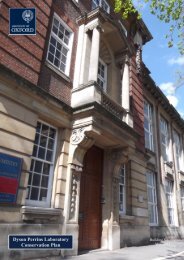The New Bodleian Library Conservation Plan - Central ...
The New Bodleian Library Conservation Plan - Central ...
The New Bodleian Library Conservation Plan - Central ...
- No tags were found...
Create successful ePaper yourself
Turn your PDF publications into a flip-book with our unique Google optimized e-Paper software.
3.2 Significance as part of the <strong>Bodleian</strong> Complex3.2.1 <strong>The</strong> <strong>Bodleian</strong> Complex as a single interacting monumental centre-piece<strong>The</strong> relationship between the <strong>New</strong> <strong>Bodleian</strong> and the other library buildings of the<strong>Bodleian</strong> <strong>Library</strong> complex is of primary significance. <strong>The</strong> <strong>New</strong> <strong>Bodleian</strong> waseffectively built as a self-contained library annex to the older <strong>Bodleian</strong> building andwas intended to provide storage for the library collection. It exists as part of this groupand its original King George VI entrance was designed to create an axial vista acrossBroad Street, through the archways of the Clarendon Building and the Old <strong>Bodleian</strong>to the Radcliffe Camera. This means that one can move from Radcliffe Square toBroad Street and the <strong>New</strong> <strong>Bodleian</strong> without leaving the University’s monumental core(see Figure 5).<strong>The</strong> 2010 alterations will remove the existing plinth and open up the building façade,denoting the re-orientation of the building’s new entrance. This will provide astronger spatial connection with the historical central <strong>Bodleian</strong> buildings, with themain entrance facing directly onto the Sheldonian’s public entrance. <strong>The</strong> glazedcolonnade will provide a view of the Clarendon Building and the Sheldonian fromwithin the new public foyer of the <strong>New</strong> <strong>Bodleian</strong>, further connecting the spaces.Whilst there is a physical connection between the <strong>Bodleian</strong> buildings in the form ofthe connecting tunnel under Broad Street, more significant is the intangibleconnection that exists across the entirety of the <strong>Bodleian</strong> complex. It is the idea of the<strong>Bodleian</strong> which makes all its components significant, as the <strong>Bodleian</strong> <strong>Library</strong> is (andtraditionally has been) considered the historic and academic core of OxfordUniversity. <strong>The</strong> decision in the 1920’s to build the <strong>New</strong> <strong>Bodleian</strong> in the centre ofOxford rather than build alibrary out of town makes theassociation more substantial asthe <strong>Bodleian</strong> collection remainsphysically close to the originallibrary. <strong>The</strong> pamphlet written bylibrarian Sir Michael Sadler atthe time emphasised theimportant connection betweenthe different sections of the<strong>Bodleian</strong> <strong>Library</strong>: ‘Whatever isdone, Bodley’s end of theancient <strong>Library</strong> together withDuke Humphrey’s <strong>Library</strong> andSelden End should be inviolatedFigure 6. <strong>New</strong> Broad Street entrancefollowing current alterations.[sic.]. To destroy theirassociations with the <strong>Bodleian</strong>would be vandalism.’ 33 <strong>Bodleian</strong> <strong>Library</strong> Collections, d.221, Proofs and finished copy of <strong>The</strong> Future of the <strong>Bodleian</strong> by Sir MSadler, 1926.<strong>New</strong> <strong>Bodleian</strong> <strong>Library</strong><strong>Conservation</strong> <strong>Plan</strong>, April 201215
















